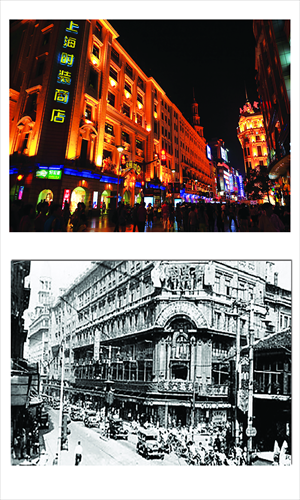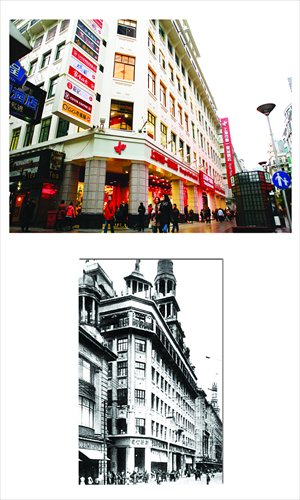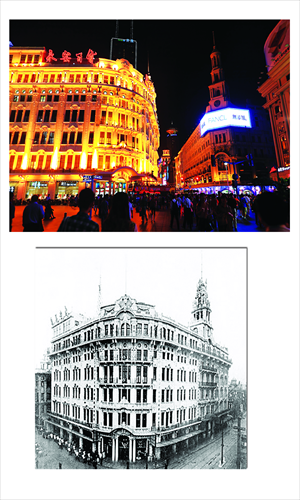When the shops showed style

On December 28, 2012, the Shanghai First Food Store on Nanjing Road East reopened after nine months of refurbishment. The same interior designer who had renovated London's Harrods department store, David Callcott, of the CADA Design Group, had redesigned the interiors of the 86-year-old eclectic-style building and turned it into a modern food palace. As shoppers flocked to the new store, history turned another page.
In the 1930s the building was the Sun Sun Department Store. Along with Sincere, Wing On and Da Sun, it was one of the four large Chinese-owned department stores on the then Nanking Road. Famous for their international products and friendly service, they were often referred to as the "big four companies," or sometimes even just "the companies." Thanks to them, Nanking Road, evolved from a small pathway called Park Lane, became a bustling shopping street and reasserted its status as Shanghai's leading commercial street.
The street has seen radical changes and clashes. In 1843, Shanghai opened its ports to international trade. European and American traders came to Shanghai, bringing foreign products and ideas both good and bad, and letting capitalism sprout in the Chinese city. By 1907, there were four large British-owned department stores in Shanghai, catering mainly to foreign customers and a small number of upper-class Chinese.
They were the Hall & Haltz Co, the Weeks & Co, the Lane Crawford & Co, and the Whiteawag, Laidlaw & Co, and were found on the eastern part of Nanking Road, near the Bund. All were owned by British businessmen. Most Chinese businessmen at that time were still running traditional shops or companies that only sold one or a few varieties of products.
The Australian connection
This changed when some Chinese businessmen opened department stores on Nanking Road. Curiously all of them came from Guangdong Province and had enjoyed similar business experiences in Australia.
The first Chinese to open a department store on Nanking Road was Ma Ying Piu, a native of Zhongshan, Guangdong Province. Ma made his first bucket of gold in Australia selling fruit and vegetables, and after that founded the first Chinese department store in Hong Kong in 1900, naming it Sincere. On a visit to Shanghai, he looked over the western part of Nanking Road, thinking it might be a good spot for a new shop.
Nanking Road at the junction of Chekiang Road (now Zhejiang Road) was near the tram stop that brought tourists from the train station, and to the south lived some of the richest people in Shanghai.
In 1914, Sincere started the construction of its Shanghai branch, and officially opened this in 1917. The baroque-style building complex originally had five floors and was a giant compared to the other one- or two-story shops on Nanking Road.
The department store, occupying the first three floors, spread over more than 10,000 luxurious square meters. More than 10,000 products were sold in the 40 departments in the store, even more than in the Hong Kong headquarters. On its opening day, fireworks were heard up and down Nanking Road and Shanghai residents crowded onto the street, wanting to look at the new store. By 1918, there were 1,000 employees working for Sincere.
In 1918, the Wing On Department Store opened facing Sincere. Wing On had a similar beginning. The founders were the brothers Kwok Lok and Kwok Chuen. They too hailed from Zhongshan, Guangdong Province. The brothers had started the Wing On fruit store in Australia in 1897. In 1907 Kwok Chuen founded the Wing On Company in Hong Kong, the second Chinese-owned department store in Hong Kong, and later established its Shanghai branch.
After its establishment, Wing On became a fierce competitor of Sincere, but the two companies managed to make it friendly, at least on the surface. The companies kept their charges at the same level, avoiding price wars, and agreed not to hire employees that had been fired or had resigned from each other.

War under the counter
But under the counter there was real competition. During the construction of Wing On's store, when the executives of Sincere learnt that it would be six-story tall, they reconstructed Sincere, adding a sixth floor to their building. Wing On, in response, built a tower on top of its sixth floor to make the building higher.
The third Chinese-owned department store, Sun Sun, opened in 1926, next to Sincere. Da Sun, also founded in Hong Kong by two Cantonese brothers, opened its Shanghai branch in 1936 on Nanking Road at the junction of Xizang Road. Towering at 10 stories, the shop was the largest of the four.
Although all the four companies were Chinese owned, three of them were registered in the UK and the US to enjoy the privileges entitled to foreign companies. Only Sun Sun was registered with the Chinese government.
"Dedicated to selling global products and everything needed in daily life." This was Wing On's motto and reflected the ideals of the four companies. Foreign products were the most popular in the 1920s, and the upmarket shops sold jewelry, shoes, clothes, suitcases, duvets, cosmetics, cigars, and wines to the well-heeled of Shanghai.
The stores offered personal service to their customers. There were chairs beside each counter for customers, and those who had been shopping for a while would be brought tea. Shop assistants would deliver the purchases, even if they were just small packages or hats.
Everything bought at these stores was handed over in the elegant gift wrapping or gift boxes that promoted the stores and told observers that the customers had purchased from these exclusive shops. At Wing On, a large flashing neon sign proclaimed: "The customer is always right."

Not just shopping
The four department stores were not for shopping. They each offered on their premises hotels, restaurants, teahouses and theaters.
Sincere was the first of the four to open a rooftop amusement area, and this idea was taken up later by the other stores. Called the Sincere Paradise, the rooftop offered the public theaters for Chinese opera and variety shows. At first only customers who had spent a certain amount of money at the store were given free admission to the rooftop park. But the shows proved increasingly popular, and with the entertainment industry blossoming in Shanghai, in 1917, the top two floors of the building were turned into an indoor entertainment area with seven theaters showing Peking and Yuju operas, Chinese and Hollywood films and variety shows. People danced in the ballroom and played snooker in the billiard rooms. Fortune-tellers, palm readers and street vendors provided extra color for visitors.
Sun Sun had its own radio station which broadcast for the first time on March 18, 1927 and was on air six hours a day, promoting its products and broadcasting performances from its rooftop garden. Famous Chinese opera singers of the day were guests on air and customers could see how the station worked by looking through the large windows as the announcers, technicians and performers went about their tasks (locals called it the "Glass Station"). It was rebuilt after the War of Resistance against Japanese Aggression (1937-45) and renamed "the victory station" to mark China's victory.
Da Sun was the first store to install escalators which ran from the first to the second floor and from the second to the third and these became major attractions with thousands of people coming just to watch or try the escalators.
Wing On was the first shop to introduce vouchers which could be used to purchase items at the store, a modern technique for a shop to increase cash flow and attract more customers.
The four department stores broke a lot of new ground. They were the first shops in Shanghai to hire female shop assistants. This was, at that stage in China, considered very unconventional - most shop assistants were male and most women were housewives.
When Sincere advertised for female shop assistants, nobody dared apply. Sincere's boss Ma's wife volunteered to be the first female assistant, showing that women could do the job and to attract young women to apply for the work. Many did, but still they accounted for just a small percentage of the shop assistants. According to records in the 1930s, women made up just 10 percent of all the shop assistants in Shanghai.

Profitable concerns
By 1929, the assets of the Sincere & Co exceeded 10 million yuan ($1.60 million), 400 times the original investment. In 1930, the total profits of Wing On totaled 10 million Hong Kong dollars ($1.29 million), four times its original capital.
In 1945 the civil war against the Kuomintang army erupted. There was hyperinflation and panic-stricken consumers rushed the four stores, trying to spend their money which was losing its worth every day. Around 1949, apart from Wing On, managers of the rest companies left the Shanghai market.
After the founding of the People's Republic of China, all four department stores were nationalized and their names and ownership have changed many times since. Today, beside the Shanghai First Food Store (the former Sun Sun Department Store), the former building of the Sincere Department Store is now the Shanghai Fashion Store, selling clothes. Da Sun has become the Shanghai No.1 Department Store. Only Wing On still uses its former Chinese name, although it is now run by the State-owned Bailian Group and no longer uses Wing On, a Cantonese translation, as its English title, but Yong'an, the pinyin version.
You can still find branches of the Wing On and Sincere department stores in Hong Kong, and capture a glimpse of the old days in the vintage logos of the brand names.